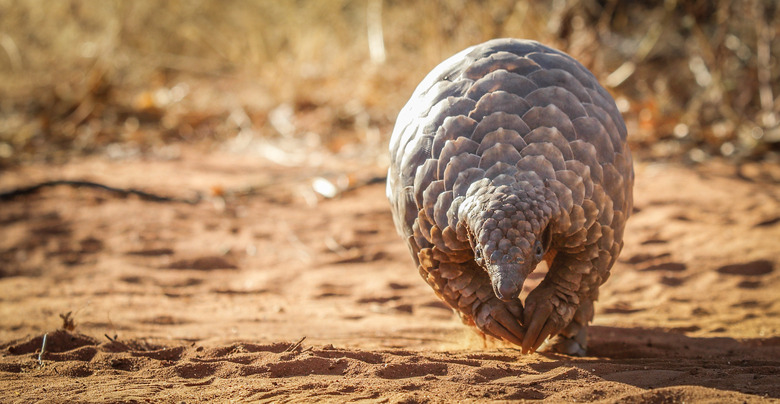For The World's Most Illegally Trafficked Animal, An Unlikely Hero
A beady-eyed hero is joining the fight to save the world's most illegally trafficked mammal, an elusive anteater known as a pangolin. A Belgian nonprofit is training some mega-sized rats to sniff out pangolins being smuggled out of Africa.
“Ant Bears”
"Ant Bears"
Native to Africa and Asia, the artichoke-resembling pangolin is armored with large plates made of keratin, the same protein found in rhino horn and fingernails. The animals are toothless, and they use their long sticky tongues to feast on ants and termites, along with stones to aid in digestion. If threatened by predators, their only defense is to roll tightly into a ball.
Trade in the easily captured pangolins is brisk; demand for their scales now exceeds that for elephant tusks or rhino horns. They're trafficked both for their meat – which is considered a delicacy in parts of Africa and Asia – and their scales that are used in traditional medicine to treat conditions ranging from inflammation to demonic possession. No scientific evidence supports these "medicinal" claims.
Despite global protections, pangolin numbers have dropped by a precipitous 90 percent. The International Union for Conservation of Nature (IUCN) estimates that a pangolin is taken from the wild every five minutes, a loss of more than 1 million animals in just the last decade. Given that each animal gives birth to only one pup per year, this level of harvest is unsustainable.
Giant Rats
Giant Rats
At a research facility in Tanzania, Belgian nonprofit APOPO is training an elite cadre of rats – Gambian giant pouched rats, specifically – to ferret out trafficked pangolins. While not exactly big enough to saddle up and ride, the more than 2-pound African-endemic rat is nearly five times the size of your average New York City rat. Their eyesight is terrible, but they have a sniffer that would put many bloodhounds to shame.
It's this olfactory prowess that has buoyed support for using the rats to ferret out trafficked wildlife. And because these scent-detecting rats are significantly smaller and more agile than canine counterparts, they can safely navigate in tight spaces, including the interiors of cargo and shipping containers.
Landmine Removal
Landmine Removal
Training these pangolin-detection rats won't be APOPO's first rodent rodeo. For more than 20 years, their "HeroRATS" have been saving human lives across Asia and Africa, sniffing out land mines in post-conflict countries. In Cambodia – the second most mine-affected country in the world, where one out of every 290 people are mine amputees – trained rats like notoriously friendly "Magawa" clear minefields and render lands safe for development. One rat can search a 200-square meter minefield in 20 minutes; a human demining technician with a metal detector would need one to four days to cover the same ground. What's more, Mgawa and his compatriots can detect TNT from a distance of more than 3 feet, even if buried underground. And while "giant" by rat standards, the animals are too light to set off the mines, so no rats are injured or killed in the demining efforts.
Disease Detection
Disease Detection
More recently, APOPO has successfully trained rats to detect tuberculosis, a disease that destroys human lungs and proves fatal if untreated. Globally, tuberculosis is the leading cause of death from an infectious disease, claiming more than 1.5 million lives per year, a quarter of these in Africa. The disease detection rats can screen a hundred cough-and-spit samples in 20 minutes; a feat that would take a technician up to five days using conventional microscopy. And the rats detect roughly 70 percent of cases, a success rate up to 50 percent higher than that of conventional methods.
Pioneering Approaches
Pioneering Approaches
Since APOPO began in 1997, their "HeroRATS" have aided in the destruction of 106,374 landmines and have identified 12,206 TB patients.
In late 2016, APOPO partnered with the Endangered Wildlife Trust of South Africa to test their rats' abilities to detect highly pungent pangolin skin and scales, as well as African ebony, and other endangered hardwoods. If successful, the U.S. Fish & Wildlife Service, one of the project's funders, hopes to deploy these whiskered teams to scrutinize cargo at busy African and Asian ports. Ultimately, the rats may one day be used to combat other types of illegal wildlife trafficking, including the smuggling of elephant ivory and rhino horn.
References
- APOPO: Detection Rats Technology
- U.S. Fish & Wildlife Service: Trained Rats and Dogs, Other Innovative Approaches to Protect Wildlife From Trafficking Funded by Service Grants
- IUCN SSC Pangolin Specialist Group: Homepage
- The Guardian: Saving the Pangolin: Giant Rats Trained to Sniff out World's Most Trafficked Mammal
- Mashable: Giant Rats Could Help Fight Wildlife Smuggling in Africa
Cite This Article
MLA
Cozzens, Barbara. "For The World's Most Illegally Trafficked Animal, An Unlikely Hero" sciencing.com, https://www.sciencing.com/for-the-worlds-most-illegally-trafficked-animal-an-unlikely-hero-13710361/. 26 March 2018.
APA
Cozzens, Barbara. (2018, March 26). For The World's Most Illegally Trafficked Animal, An Unlikely Hero. sciencing.com. Retrieved from https://www.sciencing.com/for-the-worlds-most-illegally-trafficked-animal-an-unlikely-hero-13710361/
Chicago
Cozzens, Barbara. For The World's Most Illegally Trafficked Animal, An Unlikely Hero last modified March 24, 2022. https://www.sciencing.com/for-the-worlds-most-illegally-trafficked-animal-an-unlikely-hero-13710361/
